Enhanced TDS
Identification & Functionality
- INCI Name
- Manufactured By
- Cosmetic Ingredients Functions
- Technologies
- Product Families
Features & Benefits
- Benefit Claims
- Labeling Claims
- Product Benefits
During Application
- Great absorbance
- Lubricity in skin feel
- Excellent spreadability
After Application
- Lack of stickiness/tackiness
- Highly effective skin hydration
- Instant and long-lasting moisturization (over 30 hours)
Applications & Uses
- Markets
- Applications
- Application Format
- Bath & Shower Applications
- Color Cosmetic Applications
- Personal Hygiene Applications
- Skin Care Applications
- Sun Care Applications
- Recommended Applications
ElfaMoist® AC Humectant has demonstrated very good compatibility with a broad range of raw materials and as such it offers an excellent moisturizing benefit in a wide variety of leave- on emulsion systems such as creams, lotions, antiperspirant/ deodorant, masks, eye-cream, baby lotions, BB creams, and facial mask sheets. ElfaMoist® AC Humectant also finds great utility in rinse-off products such as shower gels, moisturizing hand liquid soap, and body washes.
- Formulation Guidelines
ElfaMoist® AC Humectant is readily water soluble and is easily incorporated into water or into the water phase of an emulsion at ambient or elevated temperature conditions. ElfaMoist® AC Humectant can also be post added to a formulation during cool down. Suggested pH range of final formulations: 4-8.
Suggested use levels, as supplied
Ingredients Weight % Leave-on moisturizing products (creams, lotions, gels) 1-10 Sun care (pre and post sun care products) 1-10 Rinse-off products (shower gels, body wash, hand liquid soap, and skin cleansing systems) 1-20 Color cosmetics (Foundations, BB creams, blushes) 1-7.5
Properties
- Physical Form
- Soluble In
- SDS Physical and Chemical Properties
Value Units Test Method / Conditions pH (at 10% solution) 6.5 - 9.5 - - Odor Characteristic - - Color Light yellow - - Form Liquid - - Oxidising Properties The substance or mixture is not classified as oxidizing. - - Explosive Properties Not Explosive - - Dynamic Viscosity (at 25°C) 300 - 600 mPa.s - Relative Density (at 22°C) 1.10 - 1.15 - - Flammability (Liquids) The product is not flammable - - Flash Point 198 °C Pensky-Martens Closed Cup Soluble in Water - - - Composition
Value Units Test Method / Conditions TEA 0.5 wt% - Carbomer 0.5 wt% - DMDM Hydantoin (and) Iodopropynyl Butylcarbamate 0.5 wt% - Compound 10 wt% - Deionized water 88.5 wt% -
Regulatory & Compliance
- Certifications & Compliance
- Chemical Inventories
Technical Details & Test Data
- How does ElfaMoist AC humectant work?
Designed by Nouryon scientists, ElfaMoist® AC Humectant interacts with water and keratin (skin protein) to keep the water molecules tightly bound in the stratum corneum. This binding mechanism ensures that ElfaMoist® AC Humectant continues to improve hydration initially as well as over 30 hours. In-vitro and in-vivo tests indicate the binding mechanism of ElfaMoist® AC Humectant and its high-performance capabilities.
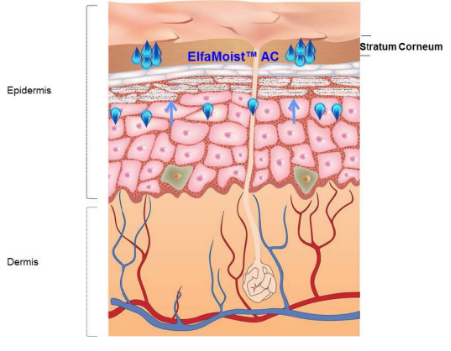
- Performance Properties
Hydrophilicity measured by dynamic vapor sorption (DVS)
An important attribute of a humectant is its ability to attract and retain moisture via water absorption. Dynamic Vapor Sorption (DVS), which is a gravimetric technique, was used to measure water absorption capability of ElfaMoist® AC Humectant as well as its synergism with other humectants.
Results:
In-vitro DVS study shows that ElfaMoist® AC Humectant binds water molecules and can be considered as hydrophilic as benchmarks in the industry (figure 2). The study also demonstrates the unique moisture absorption properties of ElfaMoist® AC Humectant when used in combination with other humectants. ElfaMoist® AC Humectant unique synergy behavior allows cosmetic chemists to formulate highly efficacious products.
Figure 2: Dynamic vapor sorption (DVS) study at 50% relative humidity (used as 50% humectant in water solution) and synergistic boost effect using 50:50 wt% blend
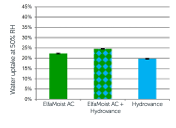
Moisturization efficacy measured by corneometer
In-vivo moisturizing efficacy is measured by the ingredient’s ability to increase the water content in the skin (stratum corneum). The measuring principle of the Corneometer is based on the dielectric constant in the medium and water has the greatest impact on the dielectric constant of the skin. Therefore, any increase in water content on skin can be determined by corneometer measurements.
Results: ElfaMoist® AC Humectant shows in-vivo skin moisturization efficacy better than or equivalent to other moisturizing agents in the marketplace (figure 3). In the case of the most premium moisturizing agents, ElfaMoist® AC Humectant performed significantly better over the 30 hours of study.
Figure 3: In-vivo Corneometer measurements - 30 hour study
Note: Gels with 10% active level of either ElfaMoist® AC Humectant, a control with water, as well as various commercial benchmarks were applied in a 4 cm diameter circle on the volar forearm of panelists. Moisture levels of the stratum corneum were measured prior to application of the gel and 30 minutes, 1, 2, 4, 6, 24, and 30 hours after application.
Formulation used in the study:Ingredients Weight % Deionized water 88.5 Compound (humectant) 10 DMDM Hydantoin (and) Iodopropynyl Butylcarbamate 0.5 Carbomer 0.5 TEA 0.5
ElfaMoist® AC Humectant compared with glycerin. Furthermore, ElfaMoist® AC Humectant was evaluated using corneometer vs glycerin at 5% active over 30 hours.
Results:
ElfaMoist® AC Humectant shows in-vivo skin moisturization efficacy better than Glycerin -- the benchmark for moisturization in the industry -- at 5% active levels (figure 4). Therefore, when compared directly with Glycerin, ElfaMoist® AC Humectant has demonstrated better performance instantly as well as over 30 hours.
Figure 4: In vivo t-test corneometer (5% active in 0.5% carbopol 940 gel)
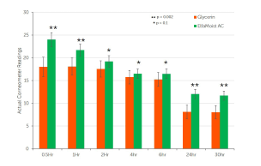
Note: Gels with 5% active level of ElfaMoist AC humectant and Glycerin, were applied in a 4cm diameter circle on the volar forearm of panelists. Moisture levels of the stratum corneum were measured prior to application of the gel and 30 minutes, 1, 2, 4, 6, 24, and 30 hours after application.
Instant and long-lasting moisturization The in-vivo corneometer study demonstrated that ElfaMoist AC humectant is capable of delivering outstanding instant (figure 5) and long-lasting moisturization benefit (figure 6) by increasing hydration in the stratum corneum and effectively retaining water over 30 hours.
Results: Through Corneometer testing, it has been confirmed that ElfaMoist AC humectant instantly increases the water content of the stratum corneum and effectively retains the water over 30 hours. ElfaMoist AC humectant performs better than other humectants initially and at 30 hours.
Figure 5: In vivo corneometer study vs benchmarks and water (1 hour)
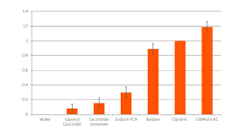
Figure 6: In vivo corneometer study vs benchmarks and water (30 hours)
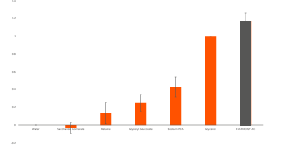
Note: Corneometer Measurements 30 hour study (using 10% active competitor polymers in 0.5% Carbopol 940 Gel).
Evaluation of moisturizing ingredient - delivery and hydration via ATR-FTIR imaging
In a study conducted by TRI Princeton, the efficacy of ElfaMoist AC humectant was measured and compared with Glycerin. Attenuated total reflectance (ATR) Fourier Transform Infrared (FTIR) imaging spectroscopy was used to analyze and visualize the deposition and penetration of these actives in the skin (stratum corneum).
ATR-FTIR imaging spectra were collected at the skin surface before treatment (control), on the skin surface after treatment (deposition) and then after sequential tape strips (penetration). Deposition and penetration The deposition of both ElfaMoist AC humectant and Glycerin on the human skin can be observed after 30 min treatment (skin after treatment).Results: Through Corneometer testing, it has been confirmed that ElfaMoist AC humectant instantly increases the water content of the stratum corneum and effectively retains the water over 30 hours. ElfaMoist AC humectant performs better than other humectants initially and at 30 hours.
Figure 7: Deposition and penetration efficacy by ATR-FTIR imaging.
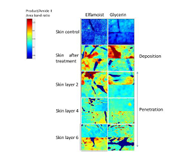
Note: The ATR-FTIR image shows the 1090-1000 cm-1 to 1580-1480 cm-1 band area ratio which normalizes the product peaks (1090-1000 cm-1) to the Amide II peaks (1580-1480 cm-1). In the ATR-FTIR images presented in this section, the higher the ratio, the redder is the image and the higher is the actives concentration. Figure 7 shows results recorded with 5% aqueous solution - 0.25mL of solution per square centimeter (12.5mg/skin cm).
Skin Hydration
Figure 8 shows new ATR-FTIR images generated by TRI/Princeton to identify potential skin moisturizing effect from ElfaMoist AC humectant and Glycerin.Results: The study shows that a moisturizing effect can be seen inside the skin after treatment with both products. This effect can be detected down to the lowest layer 6 that was analyzed for the study (figure 8).
Figure 8: Skin hydration efficacy by ATR-FTIR imaging
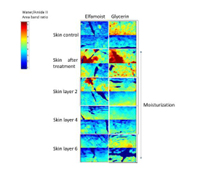
Note: The ATR-FTIR image shows the water to Amide II band area ratio. In the ATRFTIR image presented in this section, the higher the ratio, the redder is the image and the higher is the moisturization.Skin Barrier
To better understand the effects of the product application on the skin, TRI/Princeton also verified if both active penetrations disturbed the skin barrier. To assess this parameter, TRI/Princeton observed the CH₂ peak position from the lipid. The increase of a few cm-1 in the high frequencies of the CH₂ bands reflects a modification of the acyl chain packing. The CH₂ peak position is a relevant marker to analyze the lipid organization in the stratum corneum.
Results: No significant differences were observed in the lipid order indicating that ElfaMoist® AC Humectant and Glycerin do not disturb the skin barrier function and are gentle the skin.
ElfaMoist AC humectant is effective at depositing, penetrating and delivering hydration to the stratum corneum without disturbing the skin barrier (figure 9).
Figure 9: The ATR-FTIR image showing CH2 peak position
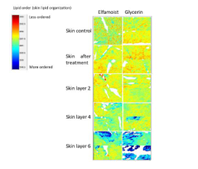
Note: In the ATR-FTIR image presented in this section, higher is the value (red) higher is lipid disorder.
Impact of formulation on delivery of ElfaMoist® AC Humectant
The deposition and the penetration of ElfaMoist AC humectant inside the skin were compared between two formulations using different concentrations (5% and 20%) by generating ATR-FTIR images.
Results: While the total amount of actives deposited on the skin is similar, the deposition and the penetration of ElfaMoist® AC Humectant can be influenced by levels of active and the type of formulation used (figure 10).

Figure 10: The ATR-FTIR image – Deposition and penetration using ElfaMoist® AC Humectant at 5% and 20% .
External sensory evaluation
Texture analyzer evaluation for spreadability Sensory Evaluation involves the detection and description of a product’s sensory characteristics. Sensory testing was done by Sensory Spectrum to determine skin-feel properties among skincare formulation samples using ElfaMoist® AC Humectant and Glycerin. Both were evaluated by expert panelists trained in Skinfeel Descriptive Analysis methodology. Gels using 10% active were used in this study.
Results: ElfaMoist® AC Humectant demonstrated statistically less tack/stickiness as well as better spreadability than Glycerin (table 1).
Table 1: 10% active gels evaluated by Sensory Spectrum.Pick-up attribute stickiness Rub-out attribute spreadability
Glycerin - - ElfaMoist® AC Humectant + + + statistically different at a 95% confidence level
Texture analyzer evaluation for spreadability
This method measures the force required to spread a sample in order to investigate textural attributes of personal care products such as lotions, creams, gels for the purpose of texture mapping and sensory correlation. The texture analyzer assesses textural properties by comparing force, distance, and time data. The texture analyzer was used to evaluate the force required to spread both ElfaMoist® AC Humectant and Glycerin.
Results: This texture analyzer study on the neat raw material (100% active) demonstrates ElfaMoist® AC Humectant requires statistically less force to spread the samples compared to Glycerin. This objective evaluation technique demonstrates good agreement with the subjective evaluation results from Sensory Spectrum and those carried out in-house (figure 13). Figure 13: Spreadability evaluated by texture analyzer.
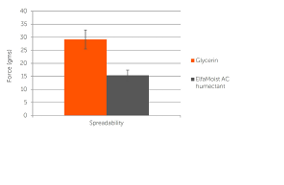
pH and viscosity stability
Formulation guidelines ElfaMoist® AC Humectant has shown excellent pH & viscosity stability at 25°C, 45°C and 50°C and freeze/thaw cycles over a period of eight weeks, after adjusting the pH to the desired range for skincare formulations.Figure 14: ElfaMoist® AC Humectant stability data
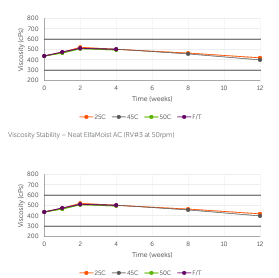
ElfaMoist® AC Humectant pH Stability prepared at 10% aqueous and pH adjusted to 5.50
Safety & Health
- Health and Safety
Information on ElfaMoist® AC Humectant relating to the EU Cosmetics Directive 76/768/EEC is available on request. The suitability of the final formulations should be confirmed in all respect by appropriate evaluation. The marketer is advised to evaluate the final formulation with regard to performance and health and safety.
Packaging & Availability
Storage & Handling
- Storage and Handling Information
ElfaMoist AC humectant can be stored under ambient conditions without undergoing decomposition or degradation. When not in use, the container should be kept covered to prevent dirt, dust, and moisture pick-up. Store in a cool, dry area. This product is freeze thaw stable.
